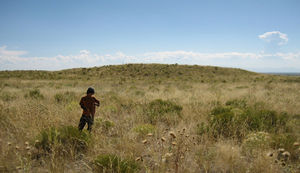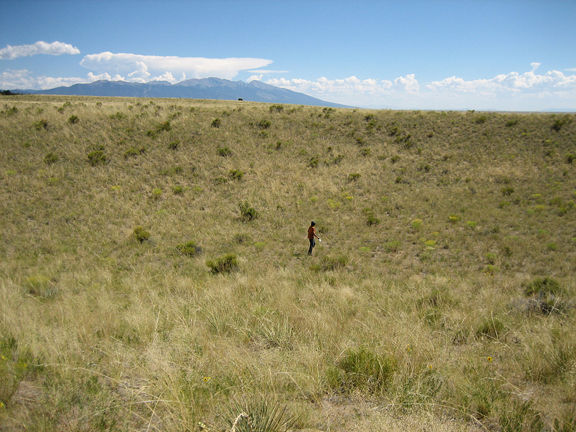Two scientists who studied the crater in 1963, Ursula Marvin and T. C Marvin, claimed otherwise, in part since they only found traces of nickel-iron spherules, with no rock flour, impact glass or other telltale signs of a meteorite at the site. Therefore they concluded that it was likely not created by a meteoric impact. They felt it more likely was of aeolian origin, or in layman's words, they felt it was formed by the wind. However, they did not use any kind of geophysical methods to validate their hypothesis, and geologists who have studied the crater since have challenged this.
Richard Madole, who studied the crater in 2004, doesn't believe wind played a role in its creation, as he notes: "The raised rim and circular form make that seem less likely because it would be difficult to form such a circular rim so close to the mountain front". The newest study made at the crater, which was conducted from this past February through May, agrees with this line of thought. It states: "The Crestone Crater has a unique geophysical signature that cannot be explained from an aeolian process and can mostly be explained through impact events".
Conducted by students from the Colorado School of Mines, this new study found no evidence that rules out impact origins, but it also found no hard evidence that completely confirmed it was from a meteor, either. What all geologists who have studied the crater agree on is that more studies are needed. But the problem today lies in funding such studies.

Above: Taken outside of the Rim: as seen approaching crater from the east, looking west. Below left: Taken inside crater (Zach Bartley is in photos, click photos for larger view)
Of the 178 confirmed meteor craters on Earth,
most have been around for millions of years, and there are few as small as
the Crestone Crater, with even fewer located in sand, as most are found in
rock. The facts that this crater is both small in size, and located in sand,
are the main reasons it is hard to determine its origin. The fact it is also
a relativity new find is the other reason why nothing official has been
declared one way or the other. But the 1963 study claims the crater should
have been deeper if it was impacted by a meteor. Its diameter was found to
be disproportionately large compared to the shallowness of the crater,
especially when compared to other meteor craters of comparable diameter. But
the fact this is located in sand changes everything. Anya Reitz, a student
working on her masters in geophysicists, and who took part in the latest
study, points out that windblown sand could have made the crater's depth
shallower than it once was. Reitz also points out that sand makes for more
erosion on what might be left of the meteorite today, than had it crashed
into rock. She also pointed out, along with Madole, that the 1963 study, or
any of the studies conducted so far, have not gone down deep enough to find
any possible meteorite.
So could this crater have been formed by a comet? Yes, but according to a few geologists that's not likely. Impacts from comets on Earth are very rare. However, the materials left behind on impact by a comet would be more in line with what has been found to date at the Crestone Crater, that being, comet impacts leave little behind because of their icy makeup.
But if the Crestone Crater wasn't formed by wind, or a
meteor, how did it get there? Scientists have noted it likely was formed by
one of those two things. But states Reitz, "The anomalies we found down
below make me think this is a meteor crater". The students' faculty advisor
for the study, Dr. Jeff Andrews-Hanna, didn't feel the crater was formed by
a meteor before the study was conducted; however, since, he has officially
changed his mind and has gone down today as saying he isn't sure anymore.
Then the question that keeps coming up is what exactly did locals all over
the San Luis Valley see in the sky crashing to the ground in that same area
back in 1892? Reitz points out that witnesses noted the fireball came from
the east, and the shape of the crater indicates that if something indeed
crash-landed there, it had to have come in from an easterly direction.
In time it will
be up to the Park Service to declare if this is a true meteor crater or not.
The heads over at the Great Sand Dunes National Park all feel that this
crater is from a meteor, but they still don't have enough proof it is yet,
and without more research and studies, finding that proof could still be
years off. But because of its small size, if the Crestone Crater is found to
be an impact crater, this will be important news, and it should lead to
future research and better understanding of smaller craters around the globe, and that alone excites scientists.
Looking for something interesting to do while visiting Crestone? Take a hike out to the crater and see for yourself our mysterious Crestone crater.

